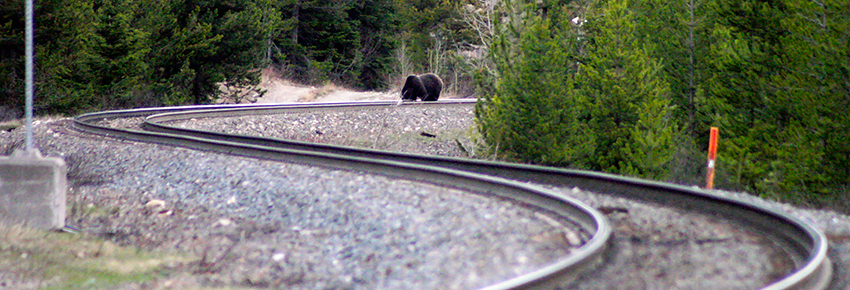
Parks Canada – Canadian Pacific Joint Grizzly Bear Research Initiative
Bears in the mountain national parks
Train strikes are a key cause of grizzly bear mortality in Banff and Yoho national parks. To better understand this issue and identify solutions, Parks Canada and Canadian Pacific launched a multi-year research program that wrapped up in 2016.
The Parks Canada – Canadian Pacific Joint Grizzly Bear Research Initiative supported researchers from Parks Canada, the University of Alberta and the University of Calgary in trying to address the following questions:
- Why are bears using the railway?
- How can we reduce the risk of grizzly-bear train collisions?
This research initiative has improved our understanding of the factors that put grizzly bears at risk along the railway.
What's next? | Research projects | Frequently asked questions | Canadian Pacific
What’s next for grizzly bears in the national parks?
Bear-train collisions pose a complex problem, with no simple solution. Parks Canada cannot eliminate the risk of grizzly bear train collisions along the rail corridor. However, through targeted research-based measures we aim to reduce the overall risk of grizzly bear mortality on the railway by:
- developing and improving wildlife travel routes adjacent to sections of track that pose a high risk for grizzly bear-train collisions, and
- using prescribed fire and forest thinning to enhance grizzly bear habitat and encourage use away from the railway.
What we have learned could benefit black bears and other large mammals and will be of value beyond Banff and Yoho national parks.
Parks Canada is a leader in reducing risk to wildlife along transportation corridors. We have made great strides to reduce human-caused bear mortalities in the mountain national parks using highway fencing and wildlife crossings, staff and visitor education, seasonal group hiking requirements, and bear-proof garbage bins.
Research Projects
Frequently Asked Questions
Why did Parks Canada and Canadian Pacific fund the research initiative?
What brings grizzly bears to the tracks?
Why don’t bears get out of the way?
What is Parks Canada doing to reduce grizzly bear-train collisions?
What about grizzly bears outside the national parks?
Why did Parks Canada and Canadian Pacific fund the research initiative?
Parks Canada and Canadian Pacific are committed to protecting and preserving wildlife. Female grizzly bears in Banff and Yoho national parks have low reproductive rates. As a result, even one bear killed is cause for concern.
Train strikes are a key cause of grizzly bear deaths in Banff and Yoho national parks. Parks Canada and Canadian Pacific are actively seeking solutions to reduce bear-train collisions.
What brings grizzly bears to the tracks?
Grizzly bears are always on the move to meet their needs for food, space, shelter and mates. Bears travel huge distances during their lives, crossing roads and railways often. They are attracted to the railway for a variety of reasons
- Foraging - The plants grizzly bears enjoy are plentiful and available earlier along the railway than in the surrounding forest.
- Travel - Like us, bears take the shortest and easiest route when they can. By traveling along the open and level railway they conserve energy.
- Easy food - Grizzly bears constantly search for food. Spilled grain and animals killed on the tracks can be tasty treats for a bear looking to bulk up.
Why don’t bears get out of the way?
Track design, landscape, food, the season and sightlines can all affect a bear’s ability to notice and escape trains. A bear’s physiology, gender and personality may also come into play.
What is Parks Canada doing to reduce grizzly bear-train collisions?
Roads and railways will always pose a risk to wildlife, but there are things we can do to help reduce this risk. Research is the first step in protecting grizzly bears. We learned railway collisions are a complex problem with no single solution.
Parks Canada will focus on encouraging bears to use habitat away from the tracks:
- Using prescribed fire, Parks Canada will improve bear habitat away from roads and railways.
- Existing trails near collision “hot-spots” on the railway will be enhanced to provide bears with safe travel routes.
- All research-based actions will be monitored to evaluate their effectiveness.
What about grizzly bears outside the national parks?
Parks Canada is supporting environmental groups, land managers and managers of other transportation corridors to protect grizzly bears. By sharing research results, Parks Canada can help protect grizzly bears outside the national parks.

- Date modified :